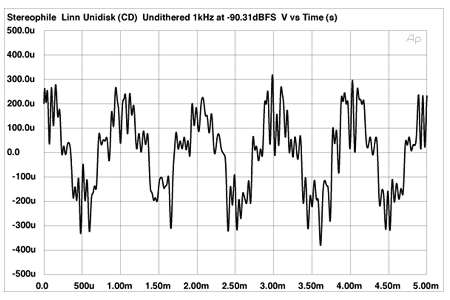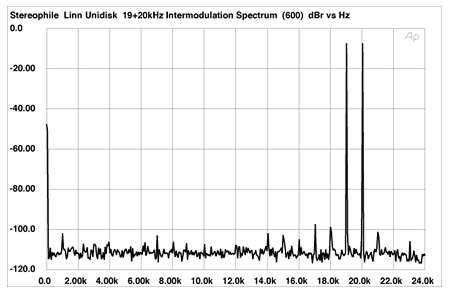| Columns Retired Columns & Blogs |
Linn Unidisk 1.1 universal disc player Measurements
Sidebar 3: Measurements
The Linn Unidisk's maximum outputs for CD replay were 2.1V unbalanced and 4.1V balanced. The figures were the same for DVD playback, but increased to 2.26V/4.41V for SACD playback. The 0.7dB difference will be audible in direct comparisons of the player's CD and SACD playback, in favor of SACD. Neither set of outputs inverted absolute polarity, and the output impedance was a low 209 ohms from the single-ended RCA jacks. This more than doubled, to 597 ohms, from the balanced XLRs, though this is still low enough not to give matching problems, particularly as the source impedance remains the same across the audioband. Error correction for CD playback was some of the best I have experienced, there being just one dropout on the track with 1.5mm gaps in the data on the Pierre Verany test CD, and occasional audible glitches with 2mm gaps.
For CD playback, the Unidisk's response was flat over most of the audioband (fig.1, top pair of traces), with a very slight top-octave rolloff. It didn't change appreciably playing back pre-emphasized data (fig.1, bottom traces). For SACD playback, the output was down 3dB a little lower in frequency, at 40kHz (fig.2), than with other SACD players I have measured. I don't yet have a DVD-A with suitable test tones, but the Unidisk's faithful reproduction of a 96kHz-sampled 12kHz squarewave (not shown) from the Chesky test DVD-V confirmed the extended bandwidth. Channel separation (not shown) was superb in the bass and midrange, at better than 110dB. It worsened to a still-excellent 90dB at 20kHz, due to the usual capacitive coupling between channels.

Fig.1 Linn Unidisk 1.1, balanced outputs, CD frequency response at -12dBFS into 100k ohms, with de-emphasis (bottom) and without (top). (Right channel dashed, 0.5dB/vertical div.)

Fig.2 Linn Unidisk 1.1, balanced outputs, SACD frequency response at -12dBFS into 100k ohms. (Right channel dashed, 1dB/vertical div.)
The rather complicated-looking graph in fig.3 shows 1/3-octave spectral analyses of the Linn Unidisk 1.1's analog output while it decoded a dithered 1kHz tone at -90dBFS from CD (16-bit LPCM encoding), DVD-V (24-bit LPCM encoding), and SACD (DSD encoding), as well as a DSD-encoded, dithered 1kHz tone at -120dBFS. The top pair of traces are for CD playback and imply that the player's noise floor is above the level of the dither noise, which is not as good as I would have liked to have seen. However, the review sample of the Unidisk emitted sporadic low-level transient pulses at random intervals when playing back CDs and CD-Rs, which may have corrupted this result. (Reaching -70dBFS, it is unlikely that these soft ticks would be heard at the listening position with music program, which is why I assume KR was unaware of any problem.)

Fig.3 Linn Unidisk 1.1, balanced, 1/3-octave spectrum of dithered 1kHz tone at -90dBFS, with noise and spuriae, 16-bit (top at 5kHz), 24-bit (bottom at 10kHz), and DSD data (top above 10kHz). (Right channel dashed.)
The 24-bit word length used by DVD lowers the 1.1's noise floor by as much as 12dB in the midrange, and less in the treble, which suggests good rather than great DAC resolution. But note the peaks at the power-supply frequency of 120Hz in the DVD traces. These are due to an unavoidable ground loop that resulted when I hooked up a composite video connection to a TV monitor so I could navigate the menus on the Chesky test DVD. (For this and many other reasons, I hate televisions.) The DSD-encoded data on SACD offered as low a noise floor as 24-bit PCM in the midrange and bass, but, as usual, less than even CD in the top audio octave. (This is not the Linn's fault, but due to the aggressive noise-shaping used in DSD encoding.) The 1kHz tone at -120dBFS can be distinguished in this graph, but has a slight positive level error due to the presence of noise. (See fig.3 in this issue's review of the Krell SACD Standard player for slightly better performance on this test.)
The Linn's DAC linearity error for CD playback was negligible down to -110dBFS (fig.4), and dominated by the recording's dither noise, which is excellent. However, the player's reproduction of an undithered 16-bit, 1kHz sinewave at -90.31dBFS (fig.5) was obscured by high-frequency noise, which correlates with the spectral analysis of the dithered CD tone in fig.3. (See fig.5 in the Krell review for a much cleaner representation of this signal's waveform.)

Fig.4 Linn Unidisk 1.1, balanced, right-channel departure from linearity, 16-bit CD data (2dB/vertical div.).

Fig.5 Linn Unidisk 1.1, waveform of undithered 1kHz sinewave at -90.31dBFS, 16-bit CD data.
The Linn Unidisk's analog output stages are not fazed by low impedances, their distortion signature not increasing even with the punishing 600 ohm load. And that signature was very low in level. Fig.6 shows a spectral analysis of the player's unbalanced output while it decoded DSD data representing a full-scale 1kHz tone. The third harmonic is the highest in level, though still negligible at -90dB (0.003%). Note, however, the appearance of the seventh harmonic. This may be at -100dB (0.001%) and way below the threshold of audibility, but it is still not something I like to see. (Check out the audibility comparisons of the second, third, and seventh harmonics on Stereophile's Test CD 2.) However, intermodulation distortion was very low, even at the Unidisk's maximum output level into 600 ohms (fig.7).

Fig.6 Linn Unidisk 1.1, unbalanced, spectrum of 1kHz sinewave, DC-1kHz, at 0dBFS into 8k ohms, DSD data (linear frequency scale).

Fig.7 Linn Unidisk 1.1, balanced, HF intermodulation spectrum, DC-24kHz, 19+20kHz at 0dBFS into 600 ohms, 24-bit DVD data (linear frequency scale).
I measured the Unidisk's rejection of word-clock jitter with the Miller Audio Research Jitter Analyzer, which performs a narrowband FFT analysis of the player's analog output while it decodes data representing a high-level tone at exactly one quarter the sample rate, over which has been laid a low-frequency squarewave at the LSB level. The measured jitter level was just 179 picoseconds peak-peak, which, while not quite as low as the 136.6ps offered by Linn's Sondek CD12, is still superbly low. Other than data-related sidebands, indicated with red numeric markers in fig.8, the only two sideband pairs of note lie at ±15.6Hz (purple "1") and ±582Hz (purple "8").
The grayed-out trace in fig.8 was taken with the Linn Unidisk playing back SACD data representing an 11.025kHz tone on Sony's "Provisional" test SACD. Because there is no low-frequency squarewave on this track, there are no data-related sidebands visible. However, there are actually no sidebands visible at all—just an elevated noise floor, which is presumably due to the DSD encoding's noiseshaping.

Fig.8 Linn Unidisk 1.1, unbalanced, high-resolution jitter spectrum of analog output signal (11.025kHz at -6dBFS sampled at 44.1kHz with LSB toggled at 229Hz). Center frequency of trace, 11.025kHz; frequency range, ±3.5kHz. (Grayed-out trace is SACD playback of 11.025kHz tone.)
The occasional low-level clicks may well be specific to our review sample, but the Unidisk's somewhat disappointing measured performance on CD playback compared with SACD and DVD caused my eyebrows to rise a little. Nevertheless, Linn's Unidisk 1.1 offers idiot-proof playback of any format of optical disc its owner cares to place in its confidence-inspiring tray. And while I have not yet auditioned the DVD-A update of Meridian's 800, Linn's Unidisk 1.1 stomped all the other DVD-A players I have tried into the ground when it came to realizing the sonic potential of the medium.—John Atkinson
- Log in or register to post comments




































